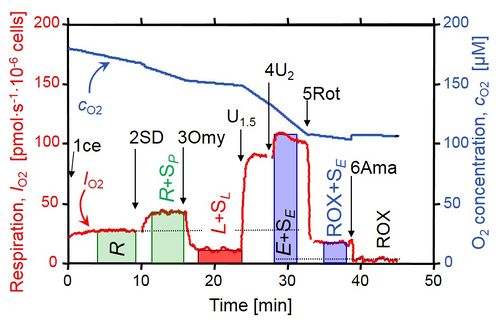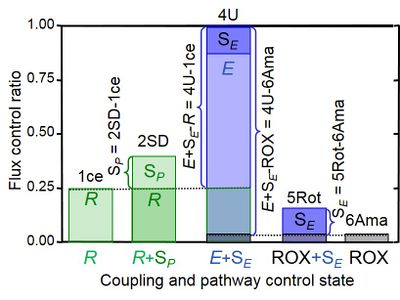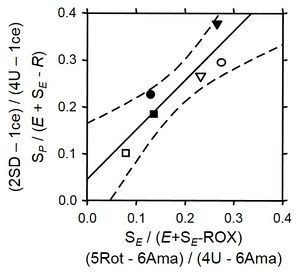Stadlmann 2006 Cell Biochem Biophys: Difference between revisions
Cocco Paolo (talk | contribs) No edit summary |
Cocco Paolo (talk | contribs) No edit summary |
||
| Line 2: | Line 2: | ||
|title=Stadlmann S, Renner K, Pollheimer J, Moser PL, Zeimet AG, Offner FA, Gnaiger E (2006) Preserved coupling of oxidative phosphorylation but decreased mitochondrial respiratory capacity in IL-1ß treated human peritoneal mesothelial cells. Cell Biochem Biophys 44:179-86. | |title=Stadlmann S, Renner K, Pollheimer J, Moser PL, Zeimet AG, Offner FA, Gnaiger E (2006) Preserved coupling of oxidative phosphorylation but decreased mitochondrial respiratory capacity in IL-1ß treated human peritoneal mesothelial cells. Cell Biochem Biophys 44:179-86. | ||
|info=[http://www.ncbi.nlm.nih.gov/pubmed/16456220 PMID: 16456220], [[File:PDF.jpg|100px|link=http://www.bioblast.at/images/c/cb/Stadlmann_2006_Cell_Biochem_Biophys.pdf |Bioblast pdf]] | |info=[http://www.ncbi.nlm.nih.gov/pubmed/16456220 PMID: 16456220], [[File:PDF.jpg|100px|link=http://www.bioblast.at/images/c/cb/Stadlmann_2006_Cell_Biochem_Biophys.pdf |Bioblast pdf]] | ||
|authors=Stadlmann S, Renner K, Pollheimer J, Moser PL, Zeimet AG, Offner FA, Gnaiger | |authors=Stadlmann S, Renner K, Pollheimer J, Moser PL, Zeimet AG, Offner FA, Gnaiger Erich | ||
|year=2006 | |year=2006 | ||
|journal=Cell Biochem Biophys | |journal=Cell Biochem Biophys | ||
Revision as of 16:15, 1 December 2020
| Stadlmann S, Renner K, Pollheimer J, Moser PL, Zeimet AG, Offner FA, Gnaiger E (2006) Preserved coupling of oxidative phosphorylation but decreased mitochondrial respiratory capacity in IL-1ß treated human peritoneal mesothelial cells. Cell Biochem Biophys 44:179-86. |
Stadlmann S, Renner K, Pollheimer J, Moser PL, Zeimet AG, Offner FA, Gnaiger Erich (2006) Cell Biochem Biophys
Abstract: The peritoneal mesothelium acts as a regulator of serosal responses to injury, infection, and neoplastic diseases. After inflammation of the serosal surfaces, proinflammatory cytokines induce an “activated” mesothelial cell phenotype, the mitochondrial aspect of which has not previously been studied. After incubation of cultured human peritoneal mesothelial cells with interleukin (IL)-1β for 48 h, respiratory activity of suspended cells was analyzed by high-resolution respirometry. Citrate synthase (CS) and lactate dehydrogenase (LDH) activities were determined by spectrophotometry. Treatment with IL-1β resulted in a significant decline of respiratory capacity (p < 0.05). Respiratory control ratios (i.e., uncoupled respiration at optimum carbonyl cyanide p-trifluoromethoxyphenylhydrazone concentration divided by oligomycin inhibited respiration measured in unpermeabilized cells) remained as high as 11, indicating well-coupled mitochondria and functional integrity of the inner mitochondrial membrane. Whereas respiratory capacities of the cells declined in proportion with decreased CS activity (p < 0.05), LDH activity increased (p < 0.05). Taken together, these results indicate that IL-1β exposure of peritoneal mesothelial cells does not lead to irreversible defects or inhibition of specific components of the respiratory chain, but is associated with a decrease of mitochondrial content of the cells that is correlated with an increase in LDH (and thus glycolytic) capacity. • Keywords: Peritoneal mesothelial cells, Interleukin-1β, Mitochondria, Respiration, Citrate synthase, Lactate dehydrogenase, Cell viability
• O2k-Network Lab: AT Innsbruck Gnaiger E, DE Regensburg Renner-Sattler K
Labels: MiParea: Respiration, mt-Biogenesis;mt-density, Pharmacology;toxicology
Stress:Cell death Organism: Human Tissue;cell: Endothelial;epithelial;mesothelial cell Preparation: Intact cells
Regulation: Coupling efficiency;uncoupling, Substrate Coupling state: ROUTINE, ET
HRR: Oxygraph-2k
Cell coupling control protocol
| Step | <Symbol in 2006 publication> | Respiratory flow | Comment |
|---|---|---|---|
| 1ce | < E > | ROUTINE, R
(Eq 1.1) 1ce = Rce (Eq 1.2) 1ce = Rvce + ROXdce |
Cells (ce=vce+dce); living cells (ce) are viable (vce) or dead (dce); if mitochondria of dce are intact, respiration of dce is identical to digitonin-permeabilized cells (pce). dce without substrate are in a state of ROXdce.
(Eq 2) Definition: Rvce = Rvce(mt) + ROXvce |
| 2ceSD | < S > | R + SP
(Eq 3) 2ceSD = Rvce + SP,dce |
ROUTINE respiration of vce is not affected by extracellular succinate and ADP (SD); dce (with intact mt) are in state SP,dce. Limitation: In the absence of rotenone, S-OXPHOS capacity may be underestimated in some types of mitochondria, whereas it is overestimated if anaplerotic pathways from malate are active, e.g. mt-malic enzyme would additionally activate the N-pathway.
(Eq 4) Definition: SP,dce = SP,dce(mt) + ROXdce |
| 3ceOmy | < O > | LEAK, L + SL
(Eq 5) 3ceOmy = Lvce + SL,dce |
vce and dce are in the LEAK state. |
| 4ceU | < 3u > | Electron transfer pathway, E + SE
(Eq 6.1) 4ceU = Evce + SE,dce (Eq 6.2) 4ceU = Evce(mt) + SE,dce(mt) + ROXce |
vce and dce are in the ET pathway state.
(Eq 7.1) Definition: Evce = Evce(mt) + ROXvce (Eq 7.2) Definition: SE,dce = SE,dce(mt) + ROXdce |
| 5ceRot | < R > | ROX + SE
(Eq 8.1) 5ceRot = ROXce + SE,dce(mt) (Eq 8.2) 5ceRot = ROXvce + SE,dce |
vce are in the ROX state, since succinate is not generated intracellularly after blocking CI by Rot and thus interrjupting the TCA cycle; dce (with intact mt) are in the S-ET-pathway state. |
| 6ceAma | < A > | ROX
(Eq 9) 6ceAma = ROXce |
All ce are in the ROX state.
(Eq 10) Definition: ROXce = ROXvce + ROXdce |
Cell membrane permeability index from the CCP
- In many studies of respiration using 'living cells', respiratory flow, IO2, is expressed per million cells. The total number of cells, Nce, is the sum of viable cells Nvce and dead cells Ndce. Cell viability is the ratio of viable cells in the total cell count, Nvce/Nce. Cell viability can be calculated from respirometric indices, based on the assumption that respiratory integrity of mitochondria is maintained in dce suspended in mitochondrial respiration medium MiR05.
- The labels of the axes show the respiratory states as steps (mark names), and respiratory states.
- The two indexes derived from (i) the succinate control step, and (ii) the antimycin A control step are in close agreement (modified Fig. 2A from Stadlmann et al 2006).
Succinate control step
| Step | <Symbol in 2006 publication> | Change of respiratory flow | Comment |
|---|---|---|---|
| 2ceSD-1ce | < S-E > | (Eq 11) 2ceSD-1ce = SP,dce(mt) | Stimulation of respiration by succinate & ADP (SD) in dead cells (dce, with intact mt) over endogenous ROUTINE respiration (R) in all counted cells (ce). vce are not permeable to SD, and are not stimulated by SD. dce are depleted of substrates and adenylates. Hence SD stimulates mitochondrial respiration in dce, and the difference 2SD-1ce equals the ROX-corrected (mitochondrial) S-OXPHOS capacity in dce, SP,dce - ROXdce = SP,dce(mt). |
| 4ceU – 1ce | < 3u-E > | (Eq 12) 4ceU-1ce = Evce + SE,dce(mt) - Rvce | Total capacity over endogenous ROUTINE respiration in ce=vce+dce (viable and dead
cells). All oligomycin-inhibited cells are stimulated by uncouplers (4ceU), because intact cell membranes are permeable for the uncoupler and respiration is supported by endogenous substrates in vce, whereas dce respire on succinate. (Eq 6.2) 4ceU = Evce(mt) + SE,dce(mt) + ROXce (Eq 1.2) 1ce = Rvce + ROXdce (Eq 1.3) 1ce = Rvce(mt) + ROXce (Eq 1.4) 1ce = Rvce - ROXvce + ROXce Use (Eq 6.2) and (Eq 1.3) (Eq 12.1) 4ceU-1ce = Evce(mt) + SE,dce(mt) {+ ROXce} - Rvce(mt) {- ROXce} (Eq 12.2) 4ceU-1ce = Evce(mt) - Rvce(mt) + SE,dce(mt) (Eq 13) Definition: Excess E-R capacity, ExRvce(mt) = Evce(mt) - Rvce(mt) Use (Eq 12.2) and (Eq 13) to obtain (Eq 12.3). (Eq 12.3) 4ceU-1ce = ExRvce(mt) + SE,dce(mt) |
- Succinate control and normalization of the cell membrane permeability index, dce/ce
- Mortality index (S-control)
- (Eq 14.1) dce/ce = (2ceSD - 1ce) / (4ceU - 1ce)
- Use (Eq 11) and (Eq 12.2)
- (Eq 14.2) dce/ce = SP,dce(mt) / [Evce(mt) + SP,dce(mt) - Rvce(mt)]
- Use (Eq 11) and (Eq 12.3)
- (Eq 14.3) dce/ce = SP,dce(mt) / [ExRvce(mt) + SP,dce(mt)]
- Viability index (S-control)
- (Eq 15.1) 1-dce/ce = 1- (2ceSD - 1ce) / (4ceU - 1ce)
- (Eq 15.2) 1-dce/ce = (4ceU - 2ceSD) / (4ceU - 1ce)
- (Eq 15.3) 1-dce/ce = vce/ce
- Use (Eq 6.1) 4U = Evce + SE,dce
- Viability index (S-control)
- Use (Eq 3) 2SD = Rvce + SP,dce
- Use (Eq 1.1) 1ce = Rce
- (Eq 16.1) 4ceU - 2ceSD = Evce - Rvce + SE,dce - SP,dce
- (Eq 17.1) 4ceU - 1ce = Evce + SE,dce - Rce
- (Eq 17.2) 4ceU - 1ce = Evce(mt) + SE,dce(mt)
- (Eq 18) vce/ce = Evce - Rvce + SE,dce - SP,dce / [Evce(mt) + SE,dce(mt)]
- Limiting case of 100% viability (Nvce=Nce): SP,dce(mt) = SP,dce(mt) = 0; vce/ce = 1
- Limiting case of 0% viability (Ndce=Nce): Evce = 0; Rvce = 0; SE,dce - SP,dce ~ 0; vce/ce ~ 0
- If all cells are permeable (dce), then the viability index equals 0, since SP and ExR=SE are practically identical in many types of mitochondria, then SP/SE = 1.
Antimycin A control step
| Step | <Symbol in 2006 publication> | Change of respiratory flow | Comment |
|---|---|---|---|
| 5ceRot-6ceAma | < R-A > | (Eq 19) 5ceRot-6ceAma = SE,dce(mt) | Succinate-supported respiration in dce (in the presence of the CI inhibitor rotenone, Rot) over antimycin A–inhibited residual oxygen consumption (Ama) of all cells. This effect is specific for dce in the presence of succinate and uncoupler.
(Eq 19.1) 5ceRot-6ceAma = SE,dce + ROXvce - ROXce Use (Eq 10) ROXvce - ROXce = -ROXdce Use (Eq 7.2) SE,dce - ROXdce = SE,dce(mt). (mt) indicates ROX-corrected flow. |
| 4ceU-6ceAma | < 3u-A > | (Eq 20) 4ceU-6ceAma = Evce(mt) + SE,dce(mt) | (Eq 20.1) ET capacity, Evce + SE,dce - ROXce = Evce(mt) +SE,dce(mt). (mt) indicates ROX-corrected flow. |
- Rot and Ama control and normalization of the cell membrane permeability index, dce/ce
- Mortality index (Rot and Ama control)
- (Eq 21.1) dce/ce = (5ceRot-6ceAma) / (4ceU-6Ama)
- (Eq 21.2) dce/ce= SE,dce(mt) / Evce(mt) + SE,dce(mt)
- Viability index (Rot and Ama control)
- (Eq 22.1) 1-dce/ce = vce/ce
- (Eq 22.1) vce/ce = Evce(mt) / Evce(mt) + SE,dce(mt)
- Viability index (Rot and Ama control)
- Limiting case of 100% viability (Nvce=Nce): SE,dce(mt) = 0; vce/ce = 1
- Limiting case of 0% viability (Evce=0; vce/ce = 0
- If all cells are permeable (dce), then the viability index equals 0, since SP and ExR=SE are practically identical in many types of mitochondria, then SP/SE = 1.



